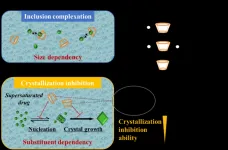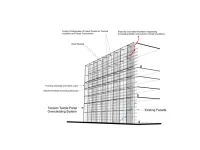(Press-News.org) HOUSTON ― Intratumoral delivery of an engineered oncolytic virus (DNX-2401) targeting glioblastoma (GBM) cells combined with subsequent immunotherapy was safe and improved survival outcomes in a subset of patients with recurrent GBM, according to results from a multi-institutional Phase I/II clinical trial co-led by researchers at The University of Texas MD Anderson Cancer Center and the University of Toronto.
The study, published today in Nature Medicine, met its primary safety endpoint and demonstrated the combination was well tolerated overall with no dose-limiting toxicities. The study did not meet its primary efficacy endpoint of objective response rate, but the combination achieved a 12-month overall survival (OS) rate of 52.7%, which is greater than the prespecified efficacy threshold of 20%. Three patients remained alive at 45, 48 and 60 months after treatment.
“This viral therapy is a different approach to the current standard of care,” said co-corresponding author Frederick Lang, M.D., chair of Neurosurgery. “Our previous trial demonstrated that not only does the virus act by killing cancer cells directly, it also effectively activates the innate immune system to convert these immunologically cold tumors into hot tumors. This led us to evaluate a combination with checkpoint inhibitors, which we now see can improve survival outcomes in a subset of patients.”
Glioblastoma is an aggressive brain cancer with a median OS of six months; patients typically experience recurrence with standard radiation and chemotherapy approaches. While immune checkpoint blockade has improved outcomes in other cancer types, the unique immunosuppressive tumor microenvironment in recurrent GBM shields it against immune cell infiltration, making it notoriously difficult to treat with immunotherapy.
Smart virus is efficient at eliminating GBM cells and activating immune response
Together with Lang, Juan Fueyo, M.D., and Candelaria Gomez-Manzano, M.D., both professors of Neuro-Oncology, are the co-inventors of DNX-2401, a cold virus engineered to selectively target and invade GBM cells while avoiding normal cells.
In previous Phase I trial results, DNX-2401 monotherapy effectively induced cancer cell death and changed the microenvironment to allow for increased T cell infiltration, resulting in an anti-tumor immune response. Twenty percent of patients with recurrent GBM remained alive for at least three years, and tumor reduction in complete responders continued for more than a year.
These results showed an increase in PD-1 checkpoint expression following treatment, suggesting that the immune system may be primed to respond to anti-PD-1 immunotherapy. Preclinical models supported this hypothesis, as treatment with pembrolizumab one week after DNX-2401 treatment improved survival outcomes compared to either treatment alone.
“Injecting a virus into a patient’s brain tumor is disruptive science, because this therapeutic strategy aims to awaken the patient’s immune system and trigger a healing from within,” Fueyo said. “After injection, patients that respond well develop inflammation inside the tumor, triggering an immune response that first kills the virus. Once the virus is wiped out, the continued immune reaction, stimulated by additional immunotherapy, destroys the cancer cells in a tightly regulated way without the side effects common to chemotherapy or radiation therapy.”
Combination therapy prolongs survival and improves quality of life in subset of patients
The current trial was designed to evaluate the combination of intratumoral DNX-2401 followed by intravenous pembrolizumab. The study enrolled 49 patients with recurrent GBM from several institutions between September 28, 2016 to January 17, 2019. The median age of patients was 53 years and 41% were women.
Forty-eight of the 49 patients (98%) were treated with one dose of DNX-2401 after biopsy, followed by pembrolizumab given one week later. The majority of adverse events were grade 1 or 2, with the most common being brain edema (37%), headache (31%) and fatigue (29%).
The combination achieved a clinical benefit, defined as stable disease or better, in more than half (56.2%) of the patients. Five patients had objective responses and two experienced tumor reduction of 80% or more at six months follow-up. By 18 months, these two patients had a complete response without evidence of disease progression.
Exploratory gene expression and immunophenotypic analysis also revealed that objective response occurred in patients with a moderately inflamed tumor microenvironment and modest PD-1 expression, meriting further investigation of which patient characteristics will determine who is more likely to benefit from this treatment.
While this study did not meet its primary efficacy endpoint, it did validate the use of DNX-2401 in combination with immune checkpoint inhibitors as a safe approach that opens the door to exploring other combinations. For instance, the researchers found that specimens from 10 patients showed elevated levels of several immune checkpoints after treatment including LAG3, TIGIT and B7-H3, highlighting these proteins as potential therapeutic targets.
“Our studies using this ‘smart virus’ are ongoing, but we are encouraged that we continue to see a small number of patients who have a very dramatic eradication of the tumor,” Gomez-Manzano said. “These results motivate us to keep searching for the best combination strategy that can optimize the use of this virus to improve patient outcomes.”
Clinical trials currently are underway using mesenchymal stem cells to deliver more of the smart virus to the tumor and more widely through the tumor. Future clinical trials will evaluate alternate treatments, such as checkpoint inhibitors or CAR T cell therapy, in combination with DNX-2401.
This study was supported by DNATrix, Inc. and Merck & Co. A full list of collaborating authors and their disclosures can be found with the full paper here.
- 30 -
END
A single patient can spark new research questions and provide answers about a disease. And when a new case is identified, investigators can make connections between them that can lead to even more powerful and persuasive ideas about cause and treatment. In a publication today in Nature Medicine, an international team led by investigators from two Mass General Brigham hospitals — Massachusetts General Hospital (MGH) and Mass Eye and Ear — reports on a new case of a patient with a genetic predisposition for developing early-onset Alzheimer’s disease who remained cognitively intact until his late 60s. Through clinical assessments ...
A research team, composed of climatologists and an astronomer, have used an improved computer model to reproduce the cycle of ice ages (glacial periods) 1.6 to 1.2 million years ago. The results show that the glacial cycle was driven primarily by astronomical forces in quite a different way than it works in the modern age. These results will help us to better understand the past, present, and future of ice sheets and the Earth’s climate.
Earth’s orbit around the Sun and its spin axis orientation change slowly over time, due to the pull of gravity from the Sun, the Moon, and other planets. These astronomical forces affect the environment on Earth due to changes in ...
In the medicine market, most newly introduced drugs and drug candidates show poor water solubility, which prevents their absorption in the body. This, in turn, limits their therapeutic efficiency. Solubilizing agents such as cyclodextrins (CDs) are commonly employed to enhance their solubility. CDs have a cyclic structure featuring a hydrophilic exterior and a hydrophobic cavity inside that can enclose drug molecules to form inclusion complexes. However, solubilization does not necessarily enhance drug adsorption in the body, since the solubilized drugs cannot ...
Ithaca, NY (May 15, 2023) - Today, the Boyce Thompson Institute (BTI) is taking a significant step forward in its mission to bridge the gap between scientific discovery and real-world application. Thanks to a generous $1M gift from the Cane-Bridge Foundation, BTI has launched an innovative translational program called "Project Vault!" to propel plant science discoveries into applications that tackle global life science challenges.
"The Cane-Bridge Foundation's support is vital to accelerate ...
SAN ANTONIO — May 15, 2023 —Southwest Research Institute (SwRI) scientists observed the first close-ups of a source of energetic particles expelled from the Sun, viewing them from just half an astronomical unit (AU), or about 46.5 million miles. The high-resolution images of the solar event were provided by ESA’s Solar Orbiter, a Sun-observing satellite launched in 2020.
“In 2022, the Solar Orbiter detected six recurrent energetic ion injections. Particles emanated along the jets, a signature of magnetic reconnection involving ...
Older buildings tend to leak heat through their walls, requiring much more energy to maintain a comfortable temperature in summer or winter. Those constructed prior to the late 1970s rarely meet today’s more rigorous energy standards. And yet they account for large proportion of the buildings standing today. In the US, about 44% of the residential building stock was built before 1970 and about half of the commercial buildings that exist today were built before the 1980s, which creates a significant need for energy retrofitting to reduce environmental impact. A new industry-academic collaboration between Jefferson and Lightweight ...
Asbestos materials were once widely used in homes, buildings, automobile brakes and many other built materials due to their strength and resistance to heat and fire, as well as to their low electrical conductivity. Unfortunately, asbestos exposure through inhalation of small fiber particles has been shown to be highly carcinogenic.
Now, for the first time, researchers from the University of Pennsylvania have shown that extremophilic bacteria from high temperature marine environments can be used to reduce asbestos’ toxicity. The research is published in ...
WHAT:
A first-in-human clinical trial of an experimental oral drug for removing radioactive contaminants from inside the body has begun. The trial is testing the safety, tolerability and processing in the body of escalating doses of the investigational drug product HOPO 14-1 in healthy adults. The National Institute of Allergy and Infectious Diseases (NIAID), part of the National Institutes of Health, is funding the Phase 1 trial, which is sponsored and conducted by SRI International of Menlo Park, California.
Internal radioactive contamination occurs when radioactive ...
Clam leases are designated underwater locations used to produce hard clams of all sizes from littlenecks to chowders. Clam production or aquaculture can be a risky business due in part to unwanted marine intruders. Among them, stealthy and highly mobile rays.
The Indian River Lagoon is one key location used for hard clam (Mercenaria mercenaria) aquaculture operations along Florida’s Atlantic coast. Clam fishermen have anecdotally reported seeing rays in clam leases and suspect that their interactions could result in damaged aquaculture gear and crushed clams. After all, ...
CAPE COD, MASSACHUSETTS – Earlier this year, the US Environmental Protection Agency proposed maximum allowable levels in drinking water for six PFAS (per- and polyfluoroalkyl substances) – so-called forever chemicals. But the draft standards do not account for half of the PFAS at contaminated sites across the country.
The findings are from a team led by the Harvard John A. Paulson School of Engineering and Applied Sciences (SEAS) and are published in the journal Environmental Science & Technology.
PFAS are present in fire retardant foams ...







